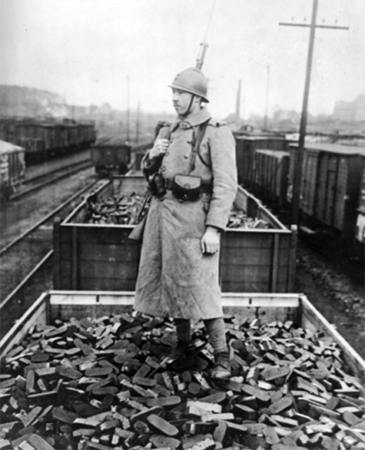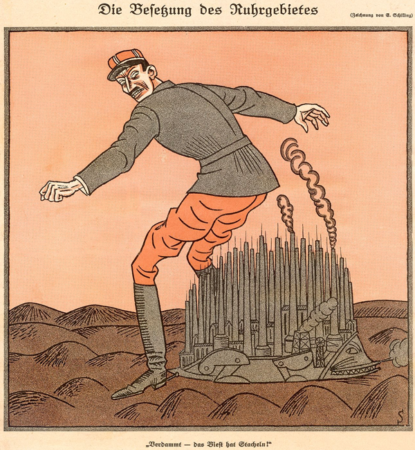
In January 1923, French and Belgian troops crossed the border and occupied numerous points in Germany’s Ruhr Valley. The Ruhr occupation would last more than two and a half years. There has been considerable debate about why France decided to occupy the Ruhr, along with whether an occupation was warranted. The conventional view is that Paris ordered troops into the Ruhr reluctantly because the Weimar government had failed to honour the terms of the Treaty of Versailles and the Reparations Commission. There is also some evidence to suggest French prime minister Raymond Poincaré and his government had been plotting to occupy the Ruhr since 1919. France had its own sizeable war debts and was suffering from a shortage of industrial resources, particularly coal. There was much to be gained by occupying the Ruhr, which housed three-quarters of Germany’s steel and coal production.
Whatever its motives, the Ruhr occupation was achieved swiftly and methodically. Once French and Belgian troops had crossed the border, they sealed off the Ruhr from the rest of Germany and began frog-marching 150,000 civilians and non-essential workers out of the area. German industrial workers remained in the Ruhr and in some cases were prevented from leaving. By July, the French had set up an exclusion zone, restricting traffic in and out of the Ruhr. The occupiers began confiscating raw materials and manufactured goods, which were loaded onto railway carts to be shipped back to France and Belgium – payment in kind for the missed reparations instalments.
The French occupation of the Ruhr sparked outrage across Germany. Several Weimar ministers declared it to be a deliberate act of French aggression, committed against a people who had been denied the means to defend themselves. Across Germany there were press reports, most of them exaggerated if not entirely fictional, of French soldiers executing or beating German workers and civilians in the Ruhr. The nationalist newspaper Deutsche Allgemeine Zeitung warned:
France herself has smashed the dictates of Versailles. But Paris must not think that the German fury is an apparition that belongs to the past so completely as the French imagine, or that it needs guns or bayonets to appear once more on the scene. Any great nation that has been driven to despair has always found the ways and means for its revenge.

The Zeitung’s ominous prediction soon became a reality. A small band of German nationalists began preparing to infiltrate the Ruhr, intent on acts of sabotage and the destruction of French equipment. They derailed trains carrying supplies to French regiments, contaminated food stocks and other acts of petty sabotage. The best-known of the saboteurs was Albert Schlageter, a 29-year-old who had fought in World War I then served with the Freikorps. French soldiers caught Schlageter red-handed, interfering with a railway line, after one of his associates betrayed him for a reward. Schlageter was arrested, court-martialled and sentenced to death. The Nazis later feted Schlageter as a national hero, a patriot and a martyr to French aggression. The man who betrayed Schlageter to the French was tracked down and murdered by a gang led by Rudolf Höss (future commandant of the notorious death camp at Auschwitz).
The industrial heart of Germany practically stopped beating. Hardly anyone worked: hardly anything ran… The population of the Ruhr area — 2 million workers, 6 million souls — had to be supported by the rest of the country. The German economy, however, called upon to subsidise an open-ended general strike, was not only denied its most important domestic products and raw materials — coal, coke, iron and steel in particular — but was robbed of its enormous foreign earnings from Rhine-Ruhr exports. The treasury was deprived of all the normal tax revenue from a huge proportion of the nation’s industry, as well as the coal tax and the income from the Ruhr railways.
Adam Fergusson, historian
The Weimar government’s official position on the Ruhr occupation was one of ‘passive resistance’. Behind the scenes, government agents encouraged trade unions to organise a general strike in the Ruhr, to freeze industrial production and hinder France’s confiscation of resources. This policy only prolonged the French occupation and sabotaged the national economy, however. On top of this, the Weimar government offered support to striking unions by promising to honour payments to their workers and civil servants in the Ruhr. This was a generous promise but an unfulfillable one: the German national treasury was very nearly empty and cash reserves were insufficient for paying two million striking industrial workers for a period of months, perhaps more than a year. The government’s last resort was to pay these salaries by ordering the printing of extra banknotes, a policy that contributed to the rampant hyperinflation of 1923.

1. Located in the country’s west, near the border with France and Belgium, the Ruhr region was Germany’s industrial heartland, home of most of its coal and steel production.
2. After the Weimar government was unable to fully meet its reparations obligations, the French and Belgian governments sent troops to occupy the Ruhr in January 1923.
3. Once established, this occupying force seized goods and raw materials from German industries and businesses. It also cleared the Ruhr by expelling non-essential citizens.
4. Stripped of their military power, Germans mounted a campaign of passive resistance, resisting the occupation with general strikes, along with some sabotage and disruption.
5. The Weimar government protested against the occupation vigorously. The government promised to support defiance in the Ruhr by paying the salaries of striking workers.

A report on the French Ruhr occupation (January 1923)
The British ambassador on the occupation of the Ruhr (January 1923)
South African leader Jan Smuts condemns the Ruhr occupation (October 1923)
© Alpha History 2014. Content on this page may not be republished or distributed without permission. For more information please refer to our Terms of Use.
This page was written by Jennifer Llewellyn, Jim Southey and Steve Thompson. To reference this page, use the following citation:
J. Llewellyn et al, “The Ruhr occupation”, Alpha History, 2014, accessed [today’s date], http://alphahistory.com/weimarrepublic/ruhr-occupation/.
